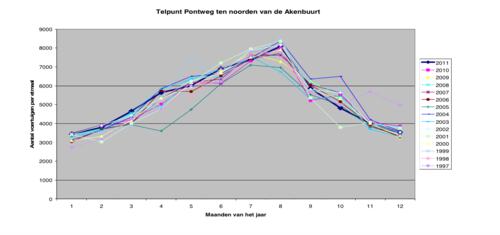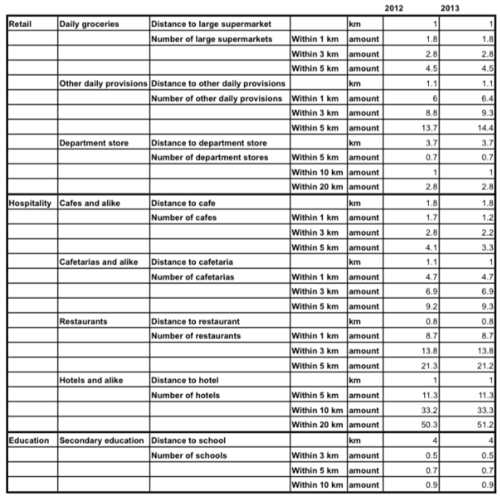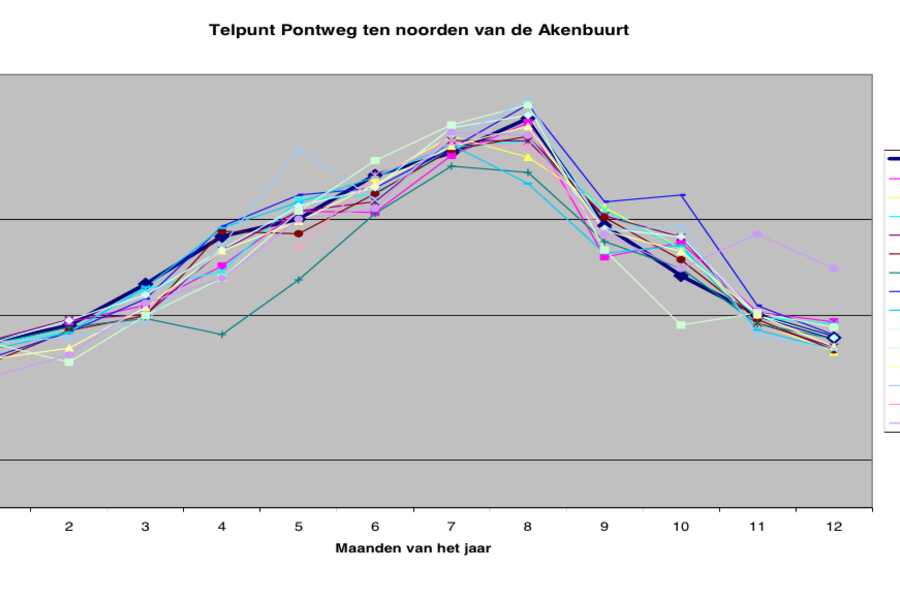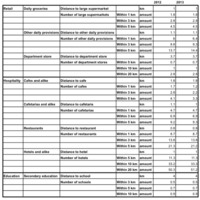Table 2.1.1 lists the amount of vehicles present on Texel in 2014. These are vehicles owned by residents and local companies. Vehicles owned by visitors of the island are not included in these numbers.
Table 2.1.1. Motorised vehicles on Texel in 2014. Source: (CBS).
|
Motorised vehicles 2014 |
||
|
All Vehicles |
total |
13359 |
|
Passenger cars |
total |
6619 |
|
Commercial vehicles |
total |
3810 |
|
Cars |
1839 |
|
|
Vans |
1340 |
|
|
Trucks |
73 |
|
|
Tractor |
300 |
|
|
Special vehicles |
112 |
|
|
Touring cars |
14 |
|
|
Trailers and semitrailers |
total |
1971 |
|
Trailers |
1301 |
|
|
Semitrailers |
670 |
|
|
Motorbikes |
total |
817 |
|
Scooters and mopeds |
total |
2113 |
|
Light mopeds |
772 |
|
|
Mopeds |
1262 |
|
|
Microcar |
59 |
|
|
Other |
20 |
Personal transport
Figure 2.1.1 shows the results of an annual vehicle count on the Pontweg, the road to and from the ferry, between 1997 and 2011. This figure clearly shows the increase of traffic in the summertime due to tourists visiting the island. In December and January between 3000 and 4000 vehicles pass the road to and from the ferry, in august the amount of cars is between 8000 and 8500.

Figure 2.1.1: Cars per day passing the Pontweg. Source: (CBS)
Table 2.2.2 shows the distance that the inhabitants of Texel on average need to travel for their basic facilities. These numbers clearly show that the inhabitants of Texel do not need to leave the island to do their day-to-day shopping activities. Only the amount of department stores is limited. As the figure 2.1.1 has clearly shown, Texel is visited by many tourists. This explains the high density of cafes, cafeterias, restaurants and hotels. Scholars can choose from one secondary school on the island, or must take the ferry to the mainland.
Table 2.2.2 Average travel distance on Texel. Source: (CBS).

Public transport
Travelling to Texel by public transport is possible. From Den Helder station, a bus service connects to the ferry. Texel offers a series of bus connection from the ferry harbour to the different villages. Other services provide connections between the villages as well (Texel).
Actors
In this section the actors involved in the mobility system of Texel are listed together with an estimation of their problem definition, needs and interests.
Inhabitants
The inhabitants of Texel are of course entirely dependent on the island’s mobility system for their personal mobility. Therefore usability, reliability and quality are the most important notions in the problem definition for the inhabitants. Usability and reliability are important because when a system shows defects, these will inevitably lead to annoyance with it's users, which will lead to resistance to the system. Because the inhabitants use the system every day, when the system is not working properly, these effects will show up very soon under inhabitants. Quality is important because the inhabitants are already used to a certain quality of their mobility network. A decline in quality will measurably lead to a resistance towards the system. The ferry is their only connection with the mainland and therefore of utmost importance. A possible change to the mobility system should not decrease the quality of mobility for the inhabitants of Texel.
Tourists
Tourists are an important actor for Texel, because they are one of the main drivers of the local economy. With regards to mobility, the tourists are concerned with the same notions as the inhabitants. Any changes however, might be less apparent to tourists because they use the system less often. Tourists may therefore be less demanding than the inhabitants of Texel. Regular visitors might be confused with any changes, but for non-frequent users the island is a strange environment anyway. The tourists wants to enjoy the island, without being distracted by mobility issues. Usability is therefore the most important notion for the tourists.
Public and private transport providers
This includes bus and taxi companies on the island. The public transport on the island is currently undergoing some changes. This means that the inhabitants and the tourists might experience some troubles with the public transport in the coming months. Both the public and private transport providers will be eager to increase efficiency as well. With a higher occupancy for instance, services can be executed more cost efficient and the companies can make more revenues. Reliability therefore is the most important notion for the transport providers. When the system is not reliable, these companies cannot provide their service. This will lead to unhappy customers and when the problem continues ultimately to declining revenues.
TESO
TESO provides the ferry service to the mainland. This company is very important for the inhabitants. This is shown by the fact that a lot of inhabitants own equity in TESO (TESO). The main interest of TESO is to provide a reliable service to and from Texel. Any changes to the system should not interfere with the reliability of the service, comparable to the public transport providers.
Rental companies
In order to give all tourists with non-sustainable transportation the opportunity to use sustainable mobility on the island, a lot of vehicles need to be rented. Rental companies will benefit from this. An increase in the amount of rental companies can be expected as well. These companies have comparable interests as the transportation companies. They want to provide a reliable service and generate revenues.
General mobility service and maintenance companies on the island
This category represents different smaller groups of local companies like garages, car washes, but also charging docks, petrol stations. These companies will have to adapt to the changing nature of the mobility system and especially the vehicles on the island. Car mechanics for instance might need to be educated in how to maintain electric motors and batteries. The same goes for bike mechanics. Petrol stations might adapt to a decline in demand and invest in electrical charging poles. A transition in the market in which these companies are active call for a transition within the companies as well. It is important that the design takes this into account.
Businesses in the tourism/hospitality industry
This category consists of companies like hotels, camp sights, restaurants, attractions and other companies that depend on tourists. Their main concern is that the island remains attractive for tourists. Therefore they will be very much concerned with the perseverance of the nature on the island and with the quality of the mobility system. These companies will need to adapt to the new mobility system as well. An increasing amount of electric vehicles calls for more charging possibilities on the premises of these companies for instance. Since Texel Airport is also mainly depending on tourism, this company can also be listed in this category.
General local businesses
Local businesses are of course as dependent on the mobility system as the inhabitants of Texel. Therefore the same notions are important to them. These companies will need to adapt maybe even more. Some companies may have car parks that they want to replace in order to fit in the sustainable mobility system. This is a considerable investment for such a company. Shops might also need to invest in charging possibilities for electric vehicles in their car parks. It is important that the designers of the system and the decision makers listen to the values and interests of these local entrepreneurs.
Local governmental bodies
The municipality is responsible for the rules and regulations on the island as well as permits. If any structural changes should be applied to the mobility network, permits will be necessary. The local government represent the local community, and therefore their position will be very much determined by the public opinion on the island. The same notions that are important for the inhabitants are important for the local government. However, the municipality also needs to control the budget of the transition and therefore has an extra interest in the shape of costs. The local government has also set the goal to become a fully sustainable island by 2020.
The municipality is assisted by the so called dorpscommisssies (village committees), which represent the interests of the separate villages on the island.
Higher government bodies (provincial, national, EU)
Higher government bodies are more concerned with the rules and regulations on a provincial/national/European level. These governments have more financial resources than the local government. Subsidies could be requested from these governments if necessary. Since Texel is a separate environment, it is an ideal location to try new initiatives on a small scale with relatively little costs.
Non Governmental Organisations (NGO’s)
NGO’s all have their own goals. Underneath some NGO's that play a part in the mobility on Texel are listed:
- ANWB (general mobility)
- Duurzaam Texel (sustainability)
- Ecomare (wildlife)
- Greenpeace (nature and wildlife)
- Rover (public transport)
- SIGT (accessibility for disabled people)
- TOP (local entrepreneurship)
- Urgenda (sustainability)
- Veilig Verkeer Nederland (mobility safety)
- VVV (tourism board)
It is important in value sensitive design, like in this research, to involve these NGO’s in an early phase of the project. NGO’s often have a strong influence on public opinion. Please note that this list is never complete since parties can enter or exit the process at any time. This is just an indication of the NGO's that are active on Texel at this moment in time.
Suppliers of technology
This is a wide array of companies that is responsible for the supply of new, sustainable technologies that improve the mobility on Texel. In this stage of the research it is not yet clear what kind of companies these are. The only thing that can be said about their values is that they will want to sell their products, but for the right price. These are companies that have the goal to make profit from their sustainable technologies. Just because they sell sustainable technologies does not mean they are not in the market to make a profit.
References
TESO. Bestuur en toezicht. Collected from TESO: https://www.teso.nl/nl/teso-mainmenu-70/bestuur-en-toezicht-mainmenu-111 the 29th of November 2014
Texel. Public Transport. Collected from Texel: http://www.texel.net/en/to-texel/public-transport/ the 29th of November 2014



